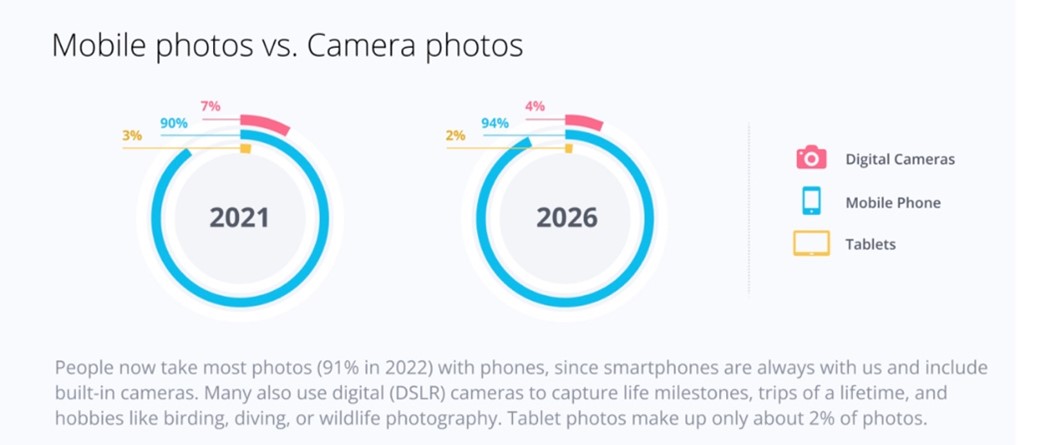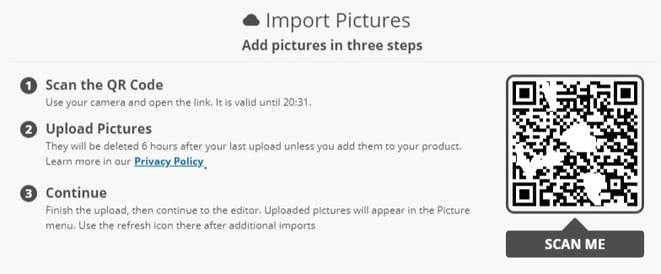7 min read
New Year, New Customers: Helping People Make the Most of Their New Tech
Jan 17, 2024

With the holidays, a wave of next-gen mobile devices with immense creative power found their way into eager hands. These devices will provide hours of enjoyment for their new owners but also offer photo product companies an opportunity to showcase how owners can get the most out of their tech — and develop additional revenue streams for themselves.
Unlocking a newfound passion for photography can drive loyalty among vast numbers of new users worldwide. However, for photo product brands to earn the trust and business of these new, wide-eyed device users, they need to earn the right. This blog details a series of achievable approaches to do exactly that.
Contents
Appeal to Their Inner Photographer
Gone are the days when cell phones were used to simply make phone calls and message people. The latest premium smartphones offer significant personal computing power and capabilities previously only available via professional photography equipment. They are also responsible for a huge amount of photos taken annually—over 1.46 trillion in 2022, approximately 84% of all photos captured worldwide that year.
Number of photos taken – 2021 to 2026:


This data underscores how essential mobile photography is becoming. From ground-breaking night modes to mesmerizing close-ups, the smartphone is becoming the nexus of photography globally across both amateur and professional tiers — and every photo taken is an opportunity for a photo product company.
Many images taken on mobile devices are simply stored digitally or shared on social media. According to research from Epson, only 2 percent of photos make it off our mobile phones, and over a third of people admitted to not having any printed pictures of family or friends at home. But these photos deserve so much more.
Offering online education on photography styles and techniques to help people take better photos is a great place to start. Providing this learning content on the device, typically via social media or a mobile app, increases the chances that users do more with the captured images. Equally, offering users a simple way to both take their best images but also transform them into physical photo products such as photo books or prints creates a natural extension for the photographer and a more permanent way for them to showcase their creative efforts.
Meet Customers in Their Channels
To better address the needs of the digital native audiences using the new devices, we need to operate within the mobile-first app ecosystem — which is a shift from the use of conventional websites from years past. According to Pew Research, Gen Z alone averages over 10 hours of daily media consumption on devices. Their prime digital "hangouts" increasingly include TikTok for entertainment and Snapchat for conversations among friends. The question then becomes: does a traditional e-commerce experience for purchasing photo products resonate among these new digital consumption habits?
As with many modern challenges, the smart way is to rethink what you want to achieve rather than forcing ill-fitting solutions.
In this case, we are looking for users to proactively turn their mobile-captured images into a photo product. But the way we achieve this is not to try and persuade users to use our apps – but instead to explore avenues that align closely with the demographic we are targeting. This approach might involve sponsored challenges on Snapchat or creating live streams with influencers showcasing how they use photo product tools and services.
Building trust through known entities grants Trojan horse-style access to audiences in our highly disposable world. In short, brands must immerse themselves in the relevant online communities to get access to younger, digital-native audiences.
Showcase Seamless Omnichannel Experience
Research cited in Time Magazine shows that the average attention span has gone from 2.5 minutes in the early 2000s to less than 50 seconds today. Multitasking is now commonplace, making the need to quickly access and learn mobile apps more critical than ever. However, this multitasking is across not just apps, but also different devices and platforms.
This nuance is particularly significant for photo products, with many users beginning more complex works like photo books on mobile devices but moving to more expansive desktop displays to complete them. This context-switching experience needs to be seamless, aka omnichannel, with intuitive creation flows that can be initiated within mobile apps and easily transferred to other devices without losing engagement.
 The mobile connect feature allows customers to easily access their photos stored on smartphones
The mobile connect feature allows customers to easily access their photos stored on smartphones
According to Salesforce, 71% of customers prefer different channels depending on context, yet present-day customers have little to zero tolerance for subpar experiences. Maintaining unified identity and process fluidity across web, mobile, and even in-store touchpoints requires a minimum effort to deliver consistency across the end-to-end user experience.
Steer User Experience with Thoughtful Nudges
While the fragmented attention spans of device users can provide challenges, they also provide opportunities. Grabbing a user's attention via a carefully deployed digital 'nudge' can bring their stream of consciousness back to photo editing from elsewhere. Far from being a nuisance, Salesforce researchers note that over 70% of younger demographics express comfort with tailored mobile insights, if relevant.
If these nudges offer a seamless on-ramp to the photo product creation workflow, they can create significant value. For example, a nudge highlighting a recently taken photo and showcasing it as a photo product can proactively drive entry to the mobile app and subsequent revenue.
Equally, for advanced products such as photo books, there is a high chance that users will start them on their mobile device but halt the process when editing becomes challenging on a small device. In this case, providing a mobile connect nudge that streamlines the process of shifting from mobile to desktop with seamless QR code scanning and image transfer can ensure that user workflows do not get interrupted or dropped.
However, while offering a way to quickly and easily take images and turn them into tangible artifacts is incredibly attractive, it requires data-responsible practices regarding user image privacy and management. But far from making this a blocker, offering user-centric and managed privacy settings as a core feature in the omnichannel experience can be a huge selling point.
Overall, carefully curated prompts highlighting favorite images or meaningful anniversary photos as custom art prints or photo books can sustain mind share and honor user privacy, strengthening the affiliation between the user and the photo product provider.
Making 2024 The Year of Device Engagement

From the moment that the first photograph, "View from the Window in Le Gras", was taken in 1826, the world has been engrossed by physical images. But despite color photos arriving in 1861 and the introduction of the first digital camera from Fujifilm in 1988, photo volumes were still relatively low until smartphones equipped with digital cameras arrived. Nowadays, billions of photos are taken on these devices every day.
Advances in the capabilities of these devices continue at a breakneck pace – almost as fast as consumer preferences change in our modern society. But all these changes provide opportunities for smart photo product brands. Higher capability smartphone cameras can trigger a creative photography passion in anyone, and it is incumbent on photo product leaders to meet enthusiasts through immersive channels wherever they spend their time.
Conversing with users on their home digital grounds and providing consumable education to help them capture better images allows photo product vendors to go beyond the traditional vendor/ consumer relationship to one built on mutual respect and trust.
Ensuring consistency across these channels and ease of use ensures that digital memories are not lost in cloud-based image archives but can transform into personalized artifacts that resonate individually. There is no foolproof formula to predict what comes next. Still, savvy photo companies who build authentic relationships through consistent care, creativity, and user enablement will be in the perfect position to drive stronger links and customer trust than ever before.
Topics: photo commerce personalization
Written by Darsi G.
Hey there! I love the whole process of article creation and enjoy writing blog posts. They not only provide the readers with great information but help me, as a digital marketer and writer, learn a lot of new things throughout the research and blog post finalization process. It is a win-win situation! P.S. Hope you like my blog posts!



